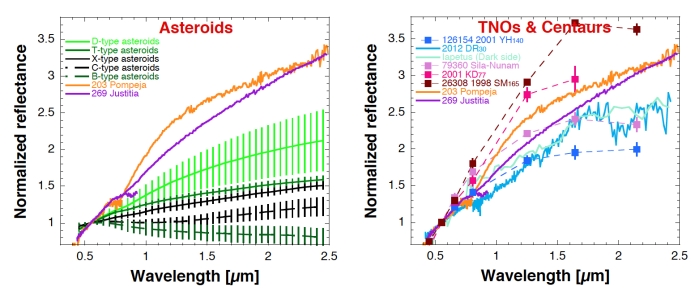In the asteroid belt between Mars and Jupiter, it seems two interplanetary visitors have made themselves at home.
203 Pompeja and 269 Justitia are much redder than any other object we've seen hanging out in the densely populated region. In fact, according to new research, their profiles are much closer to those of objects from much farther away: the Kuiper belt, out past Neptune, where Pluto makes its home.
If the discovery can be validated, it suggests that these two asteroids formed much farther away from the Sun before migrating to the asteroid belt, likely very early in the Solar System's history.
In turn, this could be evidence that the earliest stages of the Solar System's planets (when they were just planet 'seeds' known as planetesimals) first emerged far from the Sun before making their way inwards – consistent with some models of planetary system formation.
"Spectroscopic results suggest the presence of complex organic materials on the surface layer of these asteroids," the researchers wrote in their paper, "implying that they could have formed in the vicinity of Neptune and been transplanted to the main belt region during a phase of planetary migration."
The Solar System may seem nice and tidy, but it was a literal hot mess during its early years. Bits of dust and rock in the leftover molecular cloud that birthed the Sun were mooshing together to form planetesimals and asteroids and comets – all the good chunky stuff we have flying around today.
This period, astronomers believe, was a turbulent time. The planets started to form at different locations and migrated to their current positions, with larger planets forming farther out and moving inwards. The planets' movements would have created gravitational mayhem, especially the Solar System's planetary giant, Jupiter.
Eventually, things settled down, resulting in the configuration we have today: a nice selection of rocky planets in the inner Solar System, the asteroid belt out past Mars, then the gas and ice giants, followed by the Kuiper belt.
The asteroid belt sits between 2.1 and 3.3 astronomical units from the Sun. It's a very populated place, relatively speaking: It contains up to an estimated 1.9 million asteroids larger than a kilometer across (0.62 miles) and many millions more that are smaller.
203 Pompeja was discovered in 1869, and 269 Justitia in 1887, so we've known about and been observing them for some time. They're both fairly sizeable objects, too; in fact, 203 Pompeja is designated as a minor planet. Both, however, were thought to be pretty typical D-type asteroids that contain a lot of silica and carbon and make up most of the bodies in the asteroid belt.
A team of researchers led by astronomer Sunao Hasegawa of the Japanese Space Agency's Institute of Space and Astronautical Science (ISAS JAXA) discovered otherwise when they started looking closer.
Initially, they were trying to learn more about planetesimals; objects in the asteroid belt over 100 kilometers across are thought to be planetesimals that never made it all the way.
When they got to 203 Pompeja, which is around 116 kilometers across, they discovered that it was far redder than expected. So, they went looking to see if anything else in the asteroid belt had a similar color profile and found 269 Justitia.
 (ISAS JAXA)
(ISAS JAXA)
The spectrum these two objects exhibited was very far from any other asteroid in the belt for which we have spectral data. But that didn't mean there was nothing like them in the Solar System.
In fact, they were bang in the middle of the road for Kuiper belt objects (also known as trans-Neptunian objects, or TNOs), like Arrokoth (pictured at the top of this article), the farthest Solar System object visited to date.
This reddish hue is attributed to the presence of tholins, organic compounds that form when ultraviolet radiation cooks simple compounds that contain carbon, such as methane, ethane, and carbon dioxide. They are found in great abundance on icy outer Solar System bodies, but not so much in the asteroid belt.
This led the researchers to conclude that 203 Pompeja and 269 Justitia did actually form in the outer Solar System and traveled to their current position.
They must have done this some time ago because their orbits are stable and circular, and their positions are embedded in the asteroid belt.
The researchers concluded that the established presence of 203 Pompeja and 269 Justitia suggests that they moved during the planetary migration period before the Solar System had stabilized into its current configuration.
If the two objects did form out in the far reaches of the Solar System, it means two significant things. First, it validates the planetary migration model, and that means we have more information about the formation of the Solar System than we did before, helping us understand how we got here.
Second, it means there are outer Solar System bodies within much more accessible reach of our probes.
"By exploring these kinds of objects, it is highly possible that information regarding the outer regions of the Solar System beyond the organic compound snow line during the Solar System's formation can be obtained without having to travel to the outer edge of the Solar System," ISAS JAXA said in a post on its website.
"This is worth considering as candidate destination mission targets in the future."
The research has been published in The Astrophysical Journal Letters.
#Space | https://sciencespies.com/space/two-weird-red-rocks-live-in-the-asteroid-belt-and-they-dont-belong-there/
No comments:
Post a Comment